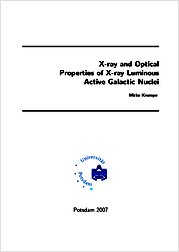| dc.contributor.author | Krumpe, Mirko | |
| dc.date.accessioned | 2010-10-12T18:23:08Z | |
| dc.date.available | 2010-10-12T18:23:08Z | |
| dc.date.issued | 2008 | |
| dc.identifier.uri | http://hdl.handle.net/11858/00-1735-0000-0001-30C4-C | |
| dc.description.abstract | Giacconi et al. (1962) discovered a diffuse cosmic X-ray background with rocket experiments when they searched for lunar X-ray emission. Later satellite missions found a spectral peak in the cosmic X-ray background at ~30 keV. Imaging X-ray satellites such as ROSAT (1990-1999) were able to resolve up to 80% of the background below 2 keV into single point sources, mainly active galaxies. The cosmic X-ray background is the integration of all accreting super-massive (several million solar masses) black holes in the centre of active galaxies over cosmic time. Synthesis models need further populations of X-ray absorbed active galaxy nuclei (AGN) in order to explain the cosmic X-ray background peak at ~30 keV. Current X-ray missions such as XMM-Newton and Chandra offer the possibility of studying these additional populations... | |
| dc.format.extent | 226 S. | |
| dc.format.mimetype | application/pdf | |
| dc.language.iso | eng | |
| dc.publisher | Univ. Potsdam | |
| dc.rights.uri | http://e-docs.geo-leo.de/rights | |
| dc.subject.ddc | 523 | |
| dc.subject.ddc | 550 | |
| dc.subject.gok | TBK 000 | |
| dc.subject.gok | TIE 900 | |
| dc.title | X-ray and optical properties of X-ray luminous active galactic nuclei | |
| dc.type | monograph | |
| dc.subject.gokverbal | Hochenergieastronomie | |
| dc.subject.gokverbal | Sonstige Sternensysteme {Astronomie} | |
| dc.identifier.doi | 10.23689/fidgeo-63 | |
| dc.identifier.ppn | 561297517 | |
| dc.type.version | publishedVersion | |
| dc.relation.collection | Astronomie, Astrophysik, Weltraumforschung | |
| dc.description.type | thesis | |


